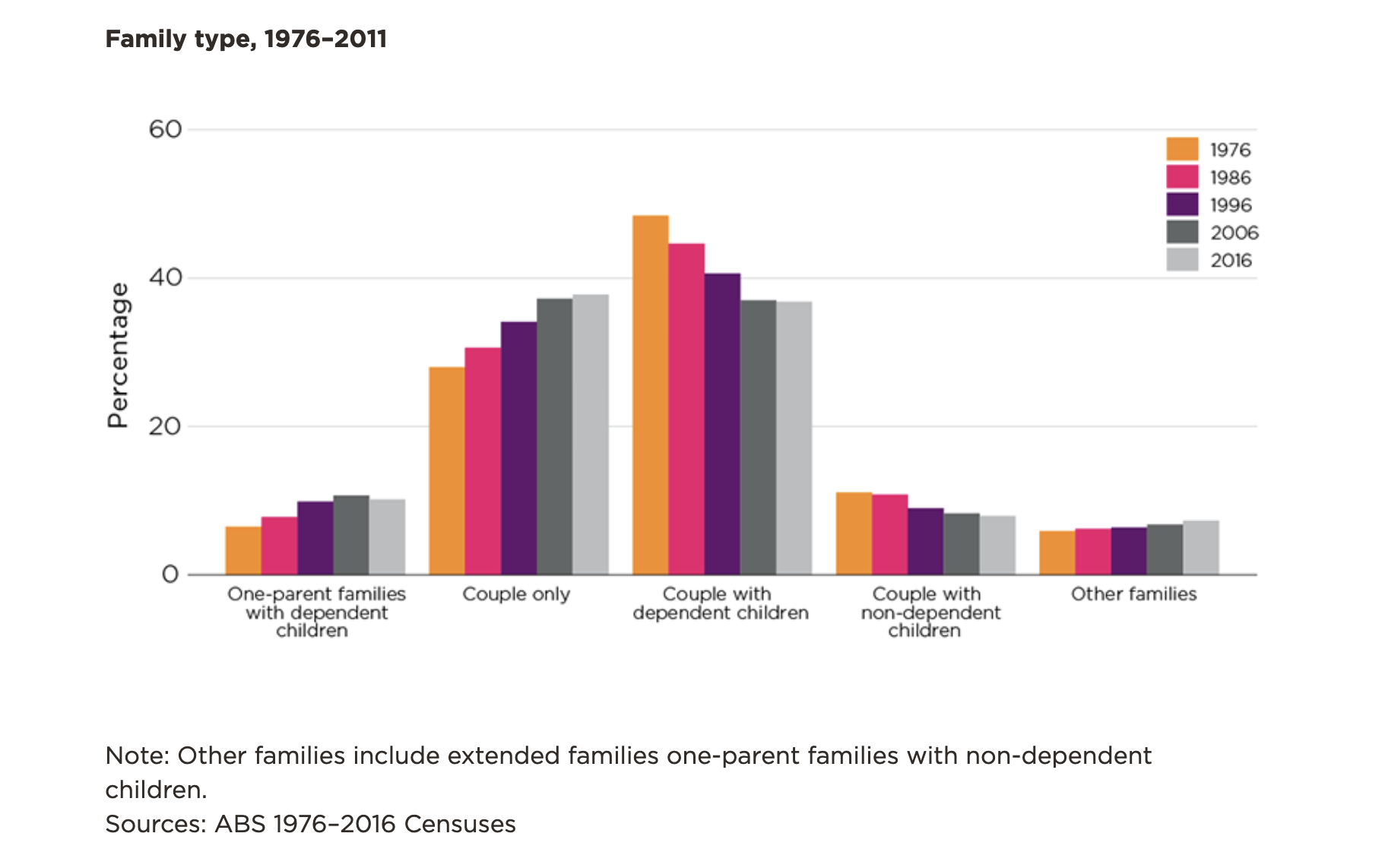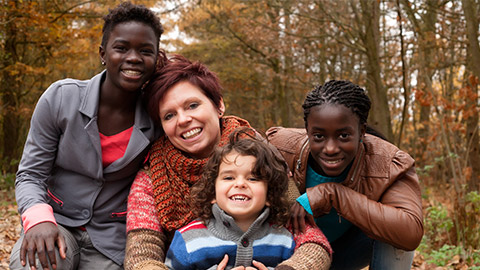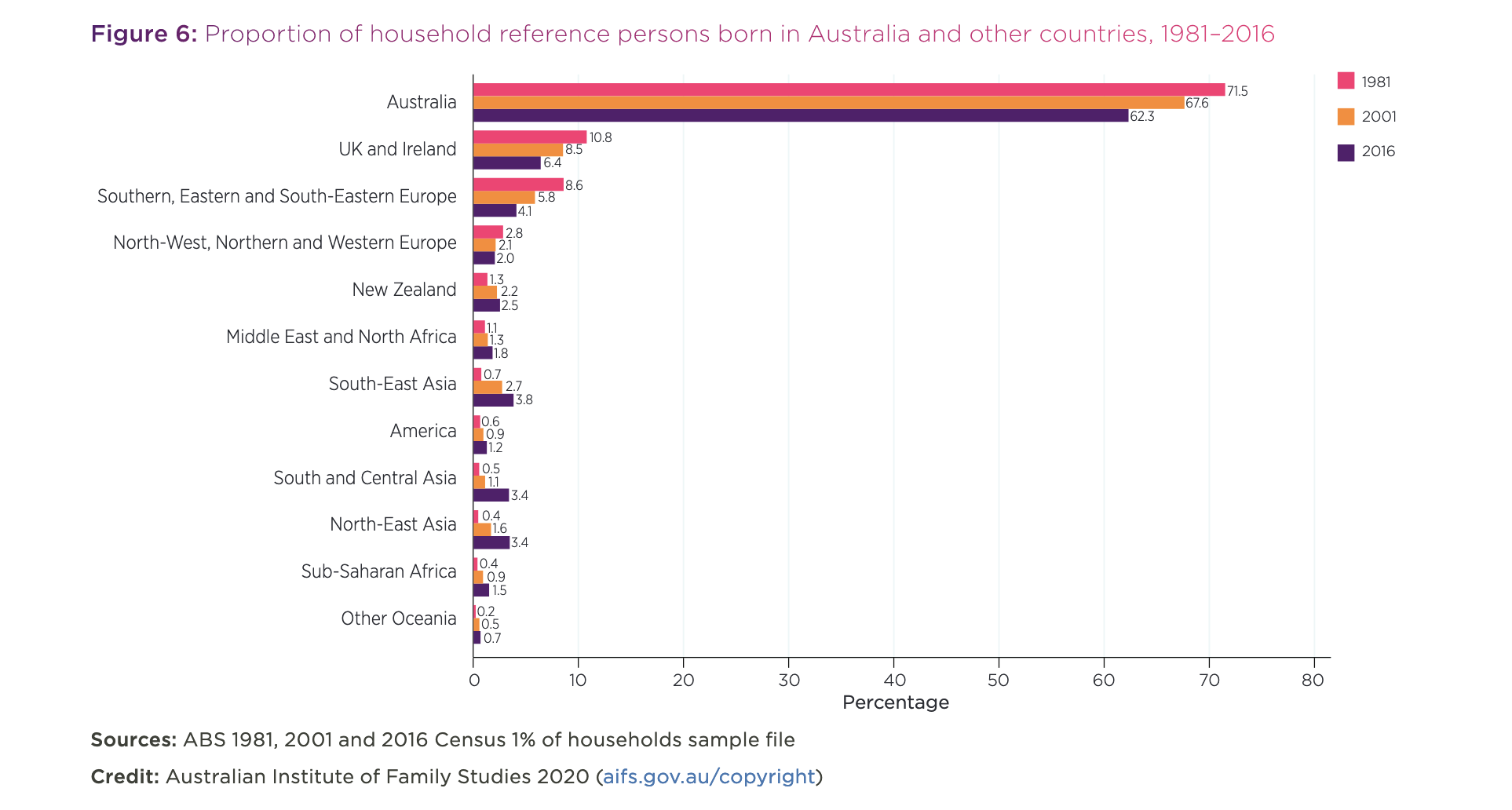Building a rapport with families and engaging with them on an ongoing basis is a core responsibility of educators. It is incredibly important for the child's sense of belonging and ability to settle in. In this topic, we will explore the different types of families educators might engage in their role in Early Childhood Education and Care. We will explore the importance of developing an effective relationship with families and how we can actively involve them in service practices.
By the end of this topic, you will understand:
- The types, structures, and diversity of families in the ECEC context
- Different parenting styles and how to demonstrate respect for the individual parenting approaches.
- Why it is important to treat parents as partners
- Strategies and approaches for developing rapport and effectively communicating with families
- How to ensure families are informed appropriately about the service and their child's education and care.
Families come in all different shapes and sizes. Each family is unique and has its culture, background, values, and beliefs. As an educator, you must understand and accept all families to create a sense of collaboration and belonging. Educators will engage with many families and must adjust their approach to ensure their relationship with each family is responsive, trustworthy, and professional, with the child's best interest in mind.
The Evolution of Families
Families have evolved, and family structure has changed during the 20th century into the diverse set of structures we see today. You will engage with many families and their children when working in the Early Childhood Sector.
Research papers from the Organisation for Economic Cooperation and Development (OECD) and the Australian Institute of Family Studies (AIFS) highlight the modern Australian family and its evolution from the past. Another source of data is the Australia Bureau of Statistics (ABS). Early childhood settings are part of the Australian Census and help to gather data for this research every few years.
Australian Institutes of Family Studies (AIFS) published a report on Australian Families Then and Now, Families in Focus for 40 years: 1980-2020 1 that shares the evolution and progression of families in the past 40 years. Their research shows that most Australian children live with both their parents until they leave home and begin to form their own families.
In 2016, the living arrangements for children under 15 years old were:
- 82% with couple families
- 18% in a single-parent family (of which 86% of children live with their mother)
- 6% in blended families
- 3% in blended families with at least one step child and no natural or adopted children
- 1% live in other arrangements, such as grandparents and families with foster children.

Data tracked over time shows that family and household structure is evolving. Some points to note include:
- It is less common in Australia than in other countries for children to live with their parents and grandparents
- Our population is aging, with many older couples or single-person households
- Extended families (living together in one household) are smaller than they were in the past
- First Nations families are occupying more households today than in the past
- Many families have immigrated to live in Australia.
Key Points
The Census and the Australian Bureau of Statistics
The Census is the largest form of information gathering conducted in Australia—it tells us about our way of life and helps us plan. Every five years, the Census counts every person and home in Australia. It is a snapshot of who we are and how we are changing.
The Census was conducted in 2021, and data can be reviewed at the Australian Bureau of Statistics.

According to the Australian Institute of Family Studies (AIFS), the change in dynamics from the traditional nuclear family in the early 20th century to other family structures is due to:
- equality of same-gender parents
- lower fertility rate
- economic impacts
- marriage rates are down
- divorce rates are up, creating single or blended families
- changes to religious stances
- social acceptance of non-children families and diverse family structures
- poverty and socio- economic/cultural impacts.
The following graph from the AIFS2 demonstrates that our population in Australia is diverse and includes people born all over the world. The majority (over 60%) of people living in households in Australia were born in Australia, dropping from over 70% in the 1980s.
The number of people born in Asia and New Zealand living in Australia has increased, and the number of people born in Ireland, Europe and the UK has dropped.

Learn More
Additional information about families can be found in the following fact, and figures articles provided on the Australian Institute of Family Studies website: Facts and Figures.
Family Structure

The term family structure refers to who are the members of a household and the relationship and dynamic between them. Family types are varied in the Australian community. It is important as an educator to understand each family's structure and the level of support specific to each family.
Website
Review this article from Zero to Three about how the past impacts of your childhood experiences can influence how you parent.
It is interesting to look at the families living in Australia and how these types have evolved. Data from the AIFS3 shows that couples with dependent children (for example, a nuclear family) have decreased significantly from 1976 through 2016. Only 36.8% of families in 2016 lived in a family unit with a couple and dependent children. This means that, in early childhood education and care, we must ensure we support all family types and avoid assuming that a child lives with their two biological parents. Single-parent families increased to 10.7% in 2006 but reduced slightly in 2016.

The following table outlines some typical family types and their characteristics.
| Family Types | Characteristics |
|---|---|
| The nuclear family (also known as a couple family) | Parents (mother and father) with their biological children living in the same home. |
| Single-parent family or custody arrangements such as shared custody | Parents who are separated, parents who have born a child through IVF alone, parents who cannot see their child due to custody order or have arrangements in place such as specific days they take care of the child(ren). |
| Same-sex parents with children | Parents who are of the same sex or transgender families living with children. One parent might be the birth parent, or they may have adopted. |
| Non-related guardianship such as adoption/foster care | Children who have been adopted, possibly from a different background, children in care with family members due to foster care arrangement, and children with foster care families (within the foster care system) who are not related to them. Some children might be brought to the service by the government, known as Guardian of the Minister. |
| Blended families or families with stepparents | Families who have separated and have reformed families with other families or with stepparents and stepchildren. They may also have more biological children together. |
| Grandparents as guardians | Children who live with their grandparents on a permanent or semi-permanent basis. Grandparents who are the guardian of the child(ren). |
Learn More
Many useful resources can be found on the Raising Children Network website to help you understand the parent's perspective around family diversity: Grown-Ups: Family Diversity.
Parenting is Individual
Each parent and family has an individual style and approach. Their family dynamic and practice can be influenced by so many things, including:
- cultural background
- life circumstances/situation
- family dynamics/size/structure
- parenting styles/modes
- access to support and information
- own childhood
- socioeconomic status
Raising children is unique for different families, cultures, and life circumstances. Many child-rearing practices have emerged and been shared. With easy access to the internet, there are a variety of parenting styles and approaches being followed by parents.
Along with family structure, as an educator, you also need to consider each family's culture and lifestyle. Each family is diverse. The level of diversity and similarities among families will differ frequently. You will need to consider how you relate and engage with the family. You may want to consider the language you use—both verbal and body language, and the time you might need to set aside to support the family and their parenting style and beliefs. You should consider your thoughts and reactions to each family and ensure you are not making assumptions. For example, saying 'mum and dad' will not capture all children, as the children you care for may have different family structures.
There is no one right way to raise a child or one ideal family situation. Parents have different beliefs about what is best for their children, which are reflected in the diverse range of child-rearing practices and parenting styles. The educator needs to understand their personal experiences of being raised or raising their own family and the influence this may have on their beliefs about parenting.
Educators may believe that the best way to parent is to be open-minded and flexible or to be strict, set boundaries, and teach manners and respect. However, it is important to consider each family situation individually, not be judgemental or biased to their own beliefs but to allow the family to make decisions about their parenting based on what will work best for their child.
Watch
Watch the YouTube video from Daniel Storage to learn more about various parenting styles and how they affect children: Parenting Styles and Their Effects on Children (35 minutes)
Examples of child-rearing practices:
| Child-Rearing Practice | Features of This Practice | Origin of This Practice |
|---|---|---|
| RIE Parenting Resources for Infant Educarers |
Provide a safe environment. Fostering a home that is safe for babies is of key importance. Allow time for solo play. With RIE, giving even very young infants opportunities to play independently is valued. Involve your child in their own care. Observe your child understand their needs. |
Originally from Magda Gerber and now driven by Janet Lanesbury |
| Finnish parenting approach | Gender equality principles. Child happiness as the focus. Child box provided with essentials from birth. Co-parenting is valued, and mums are freed to work. |
Finland Post-war requirements to reinvest in the economy Gender equality in society |
Watch
Watch the YouTube video from the Parents channel to learn about the Attachment parenting style.
Child rearing and parenting can significantly impact how someone develops as a child and who they become as an adult. Parenting forms a basis for a person's perspectives of the world, for their opinions and influences their choices.
Reflect
Consider your own parenting experience and how this has influenced your pedagogy, practice and worldview.
As educators, we need to know how to support families with their parenting styles and choices and the responsibilities of the role. Where families practice outside the safety requirements set by our National Quality Framework, it is important to sensitively support the parent to share in the decision-making around their child's care.
Examples of parenting practices that may challenge the service's health and safety considerations might include:
- wanting a child to wear an amber necklace to bed
- a child to wear a necklace at all times for religious reasons
- parents requesting a child is carried and held all-day
- asking for a child eat food outside the national dietary requirements.
In order to resolve these parental requests a discussion and review would be required.
Activity 1A
Sleep Requirements

Tina's mum dropped her off this morning and asked for her not to have a sleep. She has not been sleeping well at night, so mum (Sandy) wants to hold off on her sleep and ensure she sleeps during the night.
Tina is 4.5 months old and usually sleeps twice during the day. As an educator, it is important to consider both the child's needs and the parent's requests. Researching and basing decisions on advice from recognised health authorities can support decision-making and communication with the family.
Research and identify the sleep requirements for Tina at her age. Describe what you would communicate to Sandy about Tina's sleep.
Ensure that you keep notes for future reference, as this information will support your assessment and professional practice.
Providing Individualised Care
Each family and child is unique and brings a set of values, beliefs, culture, and family history that forms who they are and influences their care needs. Awareness of the importance of these elements of families is a key responsibility of educators and comprises part of the relationship built with families.
When determining the care needs of children, educators should ensure that their decision-making is informed by the information they have about the family and their values, beliefs, and history.
Asking parents questions about key aspects of their background and practices can support you in implementing strategies that will support the child to feel a sense of belonging and ensure smooth transitions between home and care.
- Spirituality
- Values and beliefs
- Culture
- Family history
- Lifestyle
- Experiences
- Care routine
Learning about a child and their family holistically and genuinely listening to their story will help you to plan for the child's care.
Examples of how these key aspects can contribute to your planning and care for the child include:
| Category | Information From Family | Planning for Education and Care of this Child |
|---|---|---|
| Family History | The parents divorced last year, and the children have been moving between the care of their parents and grandparents. It has been unsettled. | Consistency of care for the child and stories about living with mum than dad. |
| Experiences | Travelled to several countries and lived overseas in Africa for six months. | Supporting the child to share their experiences, bring in photos and talk about their experiences. Have worldly resources for the child to play with. |
| Beliefs | Seventh Day Adventist |
Check with the parents before celebrating events such as Christmas and Easter. Ask questions about their beliefs. |
Activity 1B
Pedagogy
Imagine you care for a child from a cultural background where they are held most of the time.
If you do not know about this cultural practice, you might expect the child to settle without being held. You might not understand why they are clinging to you.
If you know this, the strategies you implement will support the child to slowly develop their confidence to be placed on the floor to explore.
List three strategies you could implement to support the child and follow the parent's parenting style to the best of your ability.
Ensure that you keep notes for future reference, as this information will support your assessment and professional practice.
Watch
Watch the following YouTube video from Early Childhood Videos to understand more about the importance of awareness of culture.
Activity 1C
Childhood Experiences

Identify at least three elements of your pedagogy formed by your childhood experience. Once you have identified these, reflect and comment on how these experiences will make you more accepting and understanding of the families of a service.
Ensure that you keep notes for future reference, as this information will support your assessment and professional practice.
The parents are the first to nurture and support their child's development. They build a unique bond with their child and have the clearest understanding of their family's culture. Each child will be in our care for at most four years but will be with their family forever. Our role is to support families in the journey of their children. Recognising the bond and relationship the family has developed with their child is important. Be sure to acknowledge the knowledge and expertise that comes with being the child's first carer, educator, and primary attachment.
Parents are the child's first educator!
The family or parent will be the primary and first attachment of the child. From conception, they are already bonding with each other, and from birth, they build attachments. Interacting with their child, talking to them, and nurturing physical contact creates the most important attachment of a child's life and also the most important element of brain development. Therefore, the primary carer should be consulted as the most knowledgeable person for that child.
The influence of the family shapes the holistic development of a child. Families play an extensive part in the child's overall development and who that child is when they come into your care. Working in partnership with such an expert is paramount to the wellbeing and best needs of the child. Understanding the whole child is understanding all the elements involved in making them. This includes family structures, the type of home and neighbourhood they live in, the family's social life, social acceptance and activities, the independent developmental skills of the child, education or childcare factors and their involvement with their community. It includes economic factors, genes, gender, personality, language spoken, religion, friendships, culture and child-rearing practices.
Watch
Watch the following YouTube video from ECETP to learn more about the crucial role of primary caregivers.
National Standard Quality Area 6

The partnership with families is also recognised as important in the National Quality Framework under Quality Area 6: Collaborative Partnerships with Families and Communities. Services are guided to ensure that families are involved in many ways with their child's care and education and the service's decision-making.
Quality Area 6 under the National Quality Standard recognises that collaborative relationships with families are fundamental to achieving quality outcomes for children. Ensuring community partnership based on active communication, consultation, and collaboration is also essential.
Quality Area 6 has two standards and six elements, all related to relationships with families and communities. This quality area aims for services to form and maintain partnerships with families and communities to enhance children's learning, development and wellbeing.
Collaborative Partnerships With Families and Communities
| Standard 6.1 | Supportive relationships with families | Respectful relationships with families are developed and maintained, and families are supported in their parenting role. |
|---|---|---|
| Element 6.1.1 | Engagement with the service | Families are supported from enrolment to be involved in the service and contribute to service decisions |
| Element 6.1.2 | Parent views are respected |
Parent views are respected The expertise, culture, values, and beliefs of families are respected, and families share in decision-making about their child's learning and wellbeing. |
| Element 6.1.3 | Families are supported | Current information is available to families about the service and relevant community services and resources to support parenting and family wellbeing. |
| Standard 6.2 | Collaborative partnerships | Collaborative partnerships enhance children's inclusion, learning and wellbeing. |
| Standard 6.2.1 | Transitions | Continuity of learning and transitions for each child is supported by sharing information and clarifying responsibilities. |
| Standard 6.2.2 | Access and participation | Effective partnerships support children's access, inclusion, and participation in the program. |
| Standard 6.2.3 | Community engagement | The service builds relationships and engages with its community. |
Families are the child's first educators and typically play the role of Primary Caregiver and Primary Attachment as proposed by the Attachment Theory.
Watch
Watch the YouTube video from Sprouts to learn more about Attachment Theory: The Attachment Theory.
Watch the following YouTube video from Circle of Security International to find out more about the concept of Circle of Security: Circle of Security Animation (4.22 minutes)
Learn More
Read the following article from Goodwin University on the role of parents in the Reggio Emilia approach to education: The Role of Parents in a Reggio Emilia Education.
One of the most important reasons for developing positive relationships with children's families is that children respond to people like their families.
Example
Children will trust educators more if parents and educators seem to engage well and share a trusting relationship.
Effective Communication with Families

As with any relationships-based sector/profession, educators need to develop skills for engaging professionally with a diverse range of people. Building positive relationships with families requires effective communication skills.
Positive relationships between educators and children can contribute to developmental and learning outcomes for children. Educators will build positive relationships by being available and encouraging communication opportunities. They will interact with families in an open, helpful and encouraging manner. They will express genuine concern for the child(ren). Educators will provide opportunities for families to raise concerns or questions and work with them to resolve them. Once this pattern of communication is established, parents will be confident in the future to approach staff and share information. This will assist in building an ongoing positive relationship.
When parents and educators communicate effectively, they may identify areas the child can develop and support in the home and the service. Sometimes shared information will identify social challenges for a child, such as being quiet in care but outgoing at home.
There are many modalities for communicating with families of children and other people who are important partners in their care, such as psychologists, speech pathologists and occupational therapists. These communication techniques include:
- Phone calls
- Emails
- Face-to-face meetings (formal or informal)
- Chats during drop-off and pick-up of the child(ren)
- Via online portals (where applicable)
- Newsletters
- Forms and surveys
- Facebook or other social media groups or sites
- Websites.
Developing skills in the above communication modalities is important to enhance your relationship and partnership with families.
When communicating with families, ensure that communication is accessible for all family members. The format must be accessible and easy for families to understand. Information should be available in various languages for families that speak languages other than English.
Example
Ensure that all information provided online is also available and accessible in other formats where necessary if a family does not have access to the internet. Some services offer free WiFi and computer access for families to support them with tasks such as Centrelink and CCS sign-up.
When communicating with families, the communication style must be clear and reflect the professional nature of the relationship. Communication skills can be enhanced through a focus on these skills and practice.
Watch
Watch the YouTube video from Brainy Dose to improve your communication skills: 12 Ways to Improve Communication Skills Instantly
| Communication Technique | What Does This Look Like? |
|---|---|
| Active Listening | Make eye contact (where culturally relevant) and pay attention Observe body language, tone, and expressions Summarise, clarify, and ask open-ended questions Ask probing questions where relevant and paraphrase. Do not interrupt, be attuned to, and respect the feelings of others |
| Building Rapport with families and children | Be attentive and positive Be approachable and professional Use mutually comprehensive language and communication Practice active listening skills Use positive body language Be empathetic Find common ground and create shared experiences Mirror and match mannerisms where appropriate professionally Be culturally appropriate Remember a person's name Call the child by name and remember key details to show your genuine interest Come down to the child's level, make eye contact and remain attentive to their story and during the interaction |
| Collaborative Discussion and Decision-Making | Arrange appropriate times to meet Listen and question Be open-minded Ask perspectives and be open to negotiations |
| Provision of Clear Verbal Information | Ensure all information you provide is current, appropriate, and accurate Speak clearly and use a language or information format relevant to them and their needs Use appropriate language, not industry jargon where inappropriate Communicate information to families promptly, relevant to the urgency of the information and in a time stated by yourself, the service or the policy statement |
| Questioning | Consider if the question is relevant and professional Explain what the question is supporting in practice, e.g. to inform the program Consider if you are the right person to ask or answer questions; if not, delegate to the right provider Create an open relationship with the family so that they feel they can ask you questions in return Consider the delivery and location of the questioning Ensure privacy and confidentiality are upheld where relevant |
| Negotiation | Create a mutually respectful conversation Ask questions and use active listening Discuss several options in the negotiation Consider limits: service policies, United Nations Rights of the Child, the Code of Ethics, national legislation, and regulations, etc. Allow parents to make suggestions first Share knowledge and expertise where relevant, especially concerning limits Offer to do further research where a negotiation has not been finalised Try to come to a solution, but if none can be found, make another date to discuss further Stay positive and respectful at all times Remember that this is the family of the child and the first educator |
| Responding to Questions and Concerns | Acknowledge questions and respond with answers Be clear with responses Ask further questions Read body language and tone of voice to ensure concerns are addressed Talk about concerns and acknowledge issues |
Another effective communication technique is asking open-ended and closed questions to seek information and confirm understanding.
Open questions such as questions starting with:
- What, how and explain.
- For example, 'What else can I do to assist you?'
Closed questions such as questions starting with:
- Is, will, have, should, may and did.
- For example, 'Is there anything else I can do to help you?'
Activity 1E
Communication Skills
Identify and provide an example of a situation where you would use each communication technique and explain how you would use it.
- Active Listening
- Building Rapport with families and children
- Collaborative Discussion and Decision-Making
- Provision of Clear Verbal Information
- Questioning
- Negotiation
- Responding to Questions and Concerns
Ensure that you keep notes for future reference, as this information will support your assessment and professional practice.
Note
The Merriam-Webster dictionary defines rapport as a friendly, harmonious relationship, especially: a relationship characterised by agreement, mutual understanding, or empathy that makes communication possible or easy.
Activity 1F
Developing Positive Relationships With Families
Read the article by Elena Aguilar from Edutopia: 20 Tips for Developing Positive Relationships With Parents.
Choose one tip for developing positive relationships with parents and discuss why this is important.
Ensure that you keep notes for future reference, as this information will support your assessment and professional practice.

